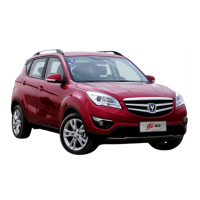CS35 2013.04
3.1.13-9 3.1.13-9Electronic Control System - ME7
A/C Compressor Control
A/C request signal is sent to ECM which controls
A/C relay to pick up and at the same time sends
the speed increase signal to electronic throttle
and switches on the electronic fan.
To ensure power output and protect the engine,
the system may discontinue A/C operation under
certain working conditions.
A/C working conditions:
• A/C stops working at temperature 108 ℃
• A/C resumes working at temperature 105
℃
After startup of A/C and evaporator, the target idle
speed of engine raises by 150 rpm.
DVVT Control
The engine variable valve timing (VVT) means
that the variation of overlap of timing and opening
of intake and exhaust valves is hydraulically VVT
controlled to enable the camshaft to rotates at
certain angles (rightwards, leftwards) and further
advance or delay the time to drive the valve to
open or close. The engine with VVT can increase
intake charge and volumetric efficiency, the
torque and power of engine can also be further
improved.
DVVT is also called dual VVT, that is both intake
camshaft and exhaust camshafts are VVT con-
trolled. It can improve engine's power perfor-
mance and economic results and also reduce
engine's emission.
1. DVVT components:
• Intake and exhaust camshafts with
inserted helical tooth push rod unit.
• Both intake and exhaust valves each has
a VVT.
• Two 3 - way solenoid change - over
valves.
• 2 Hall camshaft position sensors
2. DVVT advantages:
• Engine torque increases at 1,500 ~ 2,000
RPM.
• Smaller overlap angle of camshaft at idle,
improving idle behavior and allowing for
more complete combustion.
• Exhaust camshaft adjustment for
reduced NOX emissions and exhaust gas
circulation.
• Reduction in fuel consumption.
3. DVVT principle:
• DVVT unit is used to change the intake
and exhaust timing.
• ECM computer monitors intake and
exhaust camshaft position through dual
camshaft position sensors.
• ECM computer changes VVT control
timing according to engine speed, coolant
temperature and throttle position.
CAUTION: Single VVT is used on
JL478QEB engine and the VVT control is
only available on the intake camshaft.
Fuel vapor Emission Control
Fuel vapor emission control system is used to
prevent fuel vapor from evaporation. This vapor is
generated from the fuel during running or engine
stopped, it goes into the gasoline carbon canister
through the tank pressure control valve, and
absorbed or stored by the carbon canister. This
vapor is generated from the fuel during the run-
ning or engine stop, it goes into the carbon canis-
ter through the tank pressure control valve, and
absorbed or stored in the carbon canister.
Carbon canister sewage valve is controlled by
ECM based on various sensors signals.
Only when the following conditions are met, ECM
will open the vacuum channel of carbon canister
sewage valve.
• When the engine is at normal working
temperature.
• When the engine speed is higher than the
specified value.
• when the opening of the throttle is greater
than the idle speed position (the close
position of the throttle).
• When the engine is running within the
required load.
The result is the carbon canister is purified due to
the air flow goes through the carbon filter located
at the bottom of the canister.
mashinesoft.com
09120146259

